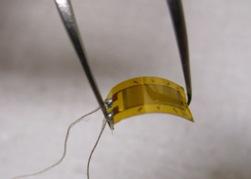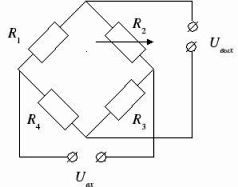Categories: Featured Articles » Home automation
Number of views: 25875
Comments on the article: 3
Strain gages in automation systems
 No closed automatic control system is conceivable without sensors, on the testimony of which feedback is formed.
No closed automatic control system is conceivable without sensors, on the testimony of which feedback is formed.
Sensors ... So different in design and principle of action. Digital and analog pressure sensors, temperature sensors, rotation speeds, efforts, current, voltage, displacement sensors ... And this is not the whole list of all kinds of sensors used in a variety of control systems.
But sensor - this is just a device that changes its signal in proportion to the measured parameter. And since the most convenient signal for transmission and conversion is electric current, the principle of operation of most sensors is based on a change in their own electrical resistance under the influence of an external factor. Therefore, sensors with built-in tensometric elements are widely used.
What is strain gauge element? This is, most often, a protected film made of a metal alloy (foil), the electrical resistance of which is directly proportional to the deformation that occurs. The alloy used is usually a mixture of nickel and copper in a certain proportion.
It is the combination of these metals that provides the strongest dependence of resistance on external mechanical influences. It turns out that everything is quite simple: they included a strain gauge resistor element in the circuit, applied a constant small voltage (several volts) to it, and by the magnitude of the current we judge the deformations, that is, the force acting on the sensor.
But in practice there is another problem. It consists in the fact that even for an alloy of copper and nickel, the change in resistance under the influence of deformation is very insignificant. Therefore, it is necessary to use amplifiers or analog-to-digital converters.
Since measurements are easier from the zero point, a strain gauge called the Wheatstone Bridge is often used in strain gauge sensors. The Wheatstone bridge is a four-terminal device that includes resistors R1, R2, R3 and R4 in its circuit. Resistors are located on the shoulders of the bridge, that is, in its independent branches.
It is very important that if all four resistances of the Wheatstone bridge are equal, the voltage at its output will be zero, regardless of the input voltage. And if the resistance in at least one arm changes, then at the output of the bridge a voltage will instantly appear, which is easy to track and which is directly proportional to the change in the resistance of the resistor.
This dependence of the output voltage of the Wheatstone bridge on the change in resistance in its shoulders is used in strain gauge sensors. That is, by placing strain gauge resistors in one or several shoulders of the bridge, we are able to track complex deformations that occur in the sensor.
Structurally, the sensor is an elastic element containing strain gauges. Ordinary resistors included in the bridge can be placed in the ADC or made in a separate block.
It is simply amazing how diverse measurements can be made using similar strain gauge sensors. Strain gages allow you to control the force, weight, pressure, displacement, deformation in itself, vibration ... Of course, strain gauges are one of the most useful inventions in the field of automation.
Alexander Molokov
See also at i.electricianexp.com
:

